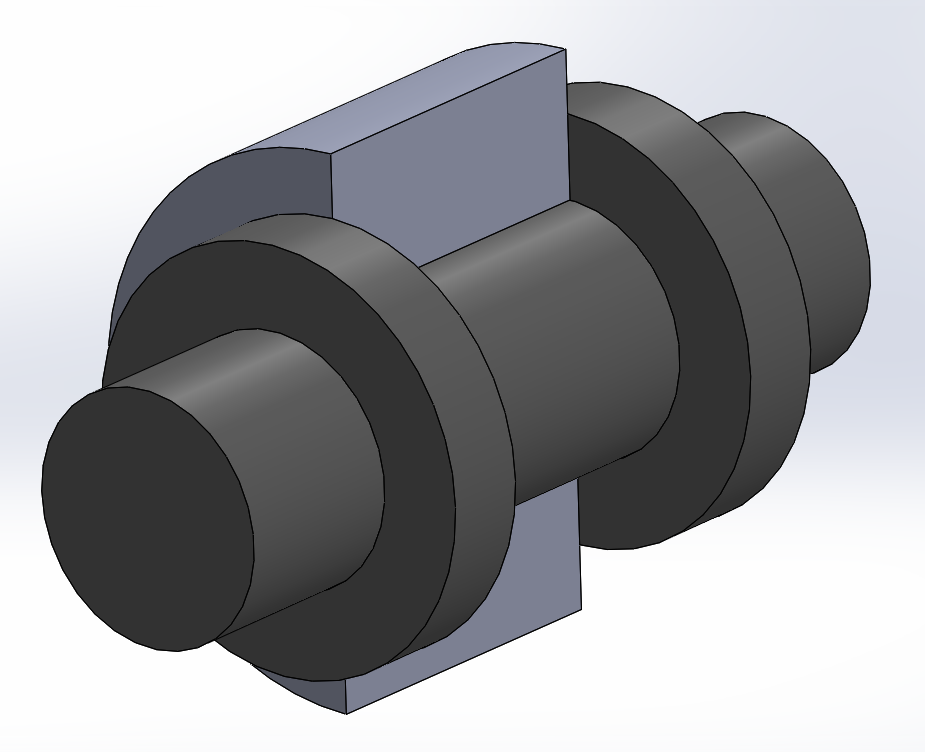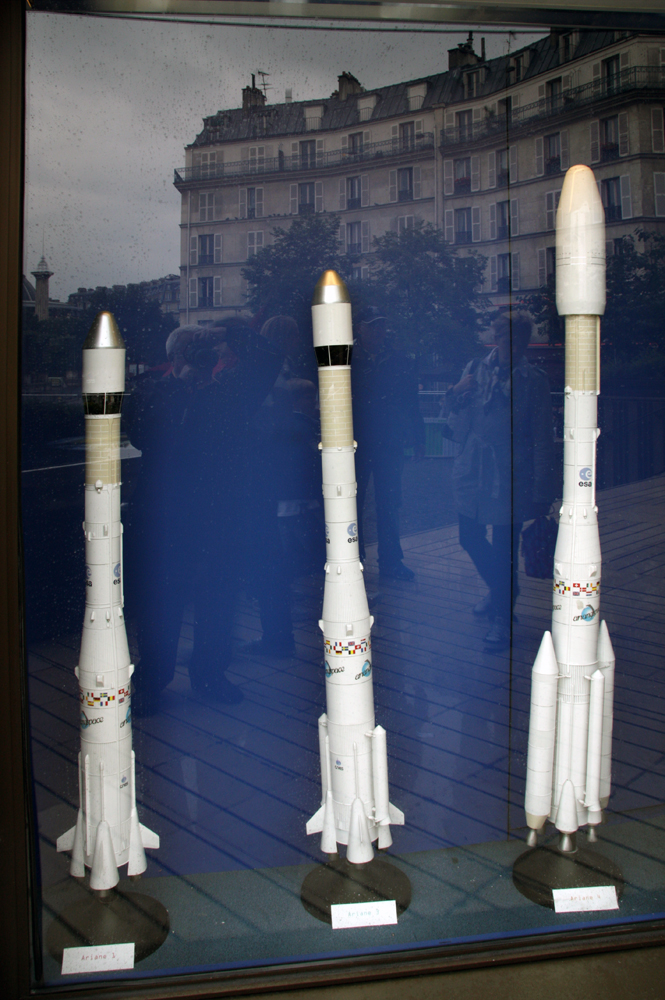|
Symphonie
The Symphonie satellites (2 satellites orbited) were the first communications satellites built by France and Germany (and the first to use three-axis stabilization in geostationary orbit with a bipropellant propulsion system) to provide geostationary orbit injection and station-keeping during their operational lifetime. After the launch of the second flight model, they comprised the first complete telecommunications satellite system (including an on-orbit spare and a dedicated ground control segment). They were the result of a program of formal cooperation between France and Germany. 1963–1970: Beginnings * January 22, 1963: Signing by President Charles de Gaulle and Chancellor Konrad Adenauer of the Élysée Treaty, an agreement for Franco-German cooperation. Start of preliminary studies in France (SAROS project) and in Germany (Olympia project) of communications satellites. * June 1967: Both countries sign an intergovernmental convention concerning the launch and ... [...More Info...] [...Related Items...] OR: [Wikipedia] [Google] [Baidu] |
Aérospatiale
Aérospatiale () was a major French state-owned aerospace manufacturer, aerospace and arms industry, defence corporation. It was founded in 1970 as () through the merger of three established state-owned companies: Sud Aviation, Nord Aviation and Société d'étude et de réalisation d'engins balistiques, SEREB. The company was headquartered in the 16th arrondissement of Paris. During its existence, Aérospatiale was one of the world's largest aerospace companies. It was Europe's biggest general aeronautics manufacturer and its leading exporter in the industry. Its activities covered civilian and military airplanes and helicopters; launch vehicles and spacecraft; as well both strategic and tactical weapon systems, from intercontinental ballistic missiles to man-portable anti-tank guided missile systems. The company was also prominently involved in many high-profile multinational programmes such as the Concorde supersonic airliner, the Ariane (rocket family), Ariane series of ... [...More Info...] [...Related Items...] OR: [Wikipedia] [Google] [Baidu] |
Attitude Control System
Spacecraft attitude control is the process of controlling the orientation of a spacecraft (vehicle or satellite) with respect to an inertial frame of reference or another entity such as the celestial sphere, certain fields, and nearby objects, etc. Controlling vehicle attitude requires actuators to apply the torques needed to orient the vehicle to a desired attitude, and algorithms to command the actuators based on the current attitude and specification of a desired attitude. Before and during attitude control can be performed, spacecraft attitude determination must be performed, which requires sensors for absolute or relative measurement. The broader integrated field that studies the combination of sensors, actuators and algorithms is called '' guidance, navigation and control'', which also involves non-attitude concepts, such as position determination and navigation. Motivation A spacecraft's attitude must typically be stabilized and controlled for a variety of reasons. ... [...More Info...] [...Related Items...] OR: [Wikipedia] [Google] [Baidu] |
Cannes
Cannes (, ; , ; ) is a city located on the French Riviera. It is a communes of France, commune located in the Alpes-Maritimes departments of France, department, and host city of the annual Cannes Film Festival, Midem, and Cannes Lions International Festival of Creativity. The city is known for its association with the rich and famous, its luxury hotels and restaurants, and for several conferences. History By the 2nd century BC, the Ligurian Oxybii established a settlement here known as ''Aegitna'' (). Historians are unsure what the name means, but the connection to Greek αἴγες "waves, surf" seems evident. The second element could be compared to the Cretan and Thessalian towns of Itanos () and Iton (); also phonetically close is the Aetolian town of Aegitium (). The area was a fishing village used as a port of call between the Lérins Islands. In 154 Before Christ, BC, it became the scene of violent but quick conflict between the troops of Quintus Opimius (consul), Quintus ... [...More Info...] [...Related Items...] OR: [Wikipedia] [Google] [Baidu] |
Reflector (antenna)
An antenna reflector is a device that reflects electromagnetic waves. Antenna reflectors can exist as a standalone device for redirecting radio frequency (RF) energy, or can be integrated as part of an antenna assembly. Standalone reflectors The function of a standalone reflector is to redirect electromagnetic (EM) energy, generally in the radio wavelength range of the electromagnetic spectrum. Common standalone reflector types are * corner reflector, which reflects the incoming signal back to the direction from which it came, commonly used in radar. * ''flat reflector,'' which reflects the signal such as a mirror and is often used as a passive repeater. Integrated reflectors When integrated into an antenna assembly, the reflector serves to modify the radiation pattern of the antenna, increasing gain in a given direction. Common integrated reflector types are * parabolic reflector, which focuses a beam signal into one point or directs a radiating signal into a beam. ... [...More Info...] [...Related Items...] OR: [Wikipedia] [Google] [Baidu] |
Mechanism (technology)
In engineering, a mechanism is a device that transforms input forces and movement into a desired set of output forces and movement. Mechanisms generally consist of moving components which may include Gears and gear trains; Belts and chain drives; cams and followers; Linkages; Friction devices, such as brakes or clutches; Structural components such as a frame, fasteners, bearings, springs, or lubricants; Various machine elements, such as splines, pins, or keys. German scientist Franz Reuleaux defines ''machine'' as "a combination of resistant bodies so arranged that by their means the mechanical forces of nature can be compelled to do work accompanied by certain determinate motion". In this context, his use of ''machine'' is generally interpreted to mean ''mechanism''. The combination of force and movement defines power, and a mechanism manages power to achieve a desired set of forces and movement. A mechanism is usually a piece of a larger process, known as a mech ... [...More Info...] [...Related Items...] OR: [Wikipedia] [Google] [Baidu] |
Temperature Control
Temperature control is a process in which change of temperature of a space (and objects collectively there within), or of a substance, is measured or otherwise detected, and the passage of heat energy into or out of the space or substance is adjusted to achieve a desired temperature. Thermoregulation is the act of keeping the body at a static and regulated temperature that is suitable for the host despite the external temperature conditions. See also * Heat exchanger * Moving bed heat exchanger * Thermal Control System * Thermodynamic equilibrium * Industrial automation * Spacecraft thermal control External links * Article about PID control by Bob Pease (from archive.org References {{DEFAULTSORT:Temperature Control Temperature control, ... [...More Info...] [...Related Items...] OR: [Wikipedia] [Google] [Baidu] |
Mechanical Engineering
Mechanical engineering is the study of physical machines and mechanism (engineering), mechanisms that may involve force and movement. It is an engineering branch that combines engineering physics and engineering mathematics, mathematics principles with materials science, to design, analyze, manufacture, and maintain mechanical systems. It is one of the oldest and broadest of the List of engineering branches, engineering branches. Mechanical engineering requires an understanding of core areas including mechanics, Analytical dynamics, dynamics, thermodynamics, materials science, design, structural analysis, and electricity. In addition to these core principles, mechanical engineers use tools such as computer-aided design (CAD), computer-aided manufacturing (CAM), computer-aided engineering (CAE), and product lifecycle management to design and analyze manufacturing plants, industrial equipment and industrial machinery, machinery, HVAC, heating and cooling systems, transport systems, ... [...More Info...] [...Related Items...] OR: [Wikipedia] [Google] [Baidu] |
General Contractor
A contractor (North American English) or builder (British English), is responsible for the day-to-day oversight of a construction site, management of vendors and trades, and the communication of information to all involved parties throughout the course of a building project. In the United States, a contractor may be a sole proprietor managing a project and performing labor or carpentry work, have a small staff, or may be a very large company managing billion dollar projects. Some builders build new homes, some are remodelers, some are developers. Description A general contractor is a construction manager employed by a client, usually upon the advice of the project's architect or engineer. General Contractors are mainly responsible for the overall coordination of a project and may also act as building designer and construction foreman (a tradesman in charge of a crew). A general contractor must first assess the project-specific documents (referred to as a bid, proposal, or tend ... [...More Info...] [...Related Items...] OR: [Wikipedia] [Google] [Baidu] |
CNES
CNES () is the French national space agency. Headquartered in central Paris, the agency is overseen by the ministries of the Armed Forces, Economy and Finance and Higher Education, Research and Innovation. It operates from the Toulouse Space Centre and the Guiana Space Centre. The president of CNES is Philippe Baptiste. CNES is a member of Institute of Space, its Applications and Technologies. It is Europe's largest national organization of its type. History CNES was established under President Charles de Gaulle in 1961. It is the world's third oldest space agency, after the Soviet space program (Russia), and NASA (United States). CNES was responsible for the training of French astronauts, until the last active CNES astronauts transferred to the European Space Agency in 2001. , CNES is working with Germany and a few other governments to start a modest research effort with the hope to propose a LOX/methane reusable launch vehicle by mid-2015. If built, flight testing w ... [...More Info...] [...Related Items...] OR: [Wikipedia] [Google] [Baidu] |




